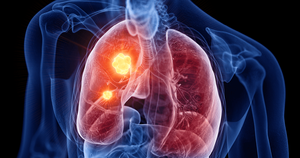Overview of Non-Small Cell Lung Cancer
Introduction
Lung cancer is classified into two major categories: non-small cell lung cancer (NSCLC), which accounts for 85% of lung cancer cases, and small-cell lung cancer (SCLC), which accounts for the remaining 15%. The focus of this module is on NSCLC, a group of epithelial lung cancer entities (carcinomas) categorized by common characteristics that distinguish them from SCLC, including comparably lower aggressiveness, slower progression, histologic commonalities (e.g., large cell size) and treatment approaches. The most common subtype of NSCLC is adenocarcinoma, followed by squamous cell carcinoma (SqCC) and large cell lung carcinoma (LCLC). Other forms of NSCLC, including mixed-type cancers (adenosquamous carcinoma, pleomorphic/sarcomatoid carcinoma), may also occur, but are generally rare.
Adenocarcinoma
Adenocarcinoma accounts for 50% of NSCLC cases. These cancers often arise in the lung periphery (the more distal airways), but can occur in the central lung. Adenocarcinomas…
To continue reading
Log in or register to continue reading. It's free!
OR
By signing up to create an account, I accept Healio's Terms of Use and Privacy Policy.
Introduction
Lung cancer is classified into two major categories: non-small cell lung cancer (NSCLC), which accounts for 85% of lung cancer cases, and small-cell lung cancer (SCLC), which accounts for the remaining 15%. The focus of this module is on NSCLC, a group of epithelial lung cancer entities (carcinomas) categorized by common characteristics that distinguish them from SCLC, including comparably lower aggressiveness, slower progression, histologic commonalities (e.g., large cell size) and treatment approaches. The most common subtype of NSCLC is adenocarcinoma, followed by squamous cell carcinoma (SqCC) and large cell lung carcinoma (LCLC). Other forms of NSCLC, including mixed-type cancers (adenosquamous carcinoma, pleomorphic/sarcomatoid carcinoma), may also occur, but are generally rare.
Adenocarcinoma
Adenocarcinoma accounts for 50% of NSCLC cases. These cancers often arise in the lung periphery (the more distal airways), but can occur in the central lung. Adenocarcinomas resemble irregularly-shaped grayish or white nodules, commonly with scarring and anthracotic pigment deposition. Pleural puckering (distortion) may be present if the tumor develops close to the pleura. Adenocarcinoma is subclassified according to the cell types involved into nonmucinous and mucinous adenocarcinoma. Nonmucinous adenocarcinoma normally exhibits a mixture of histological growth patterns, including one non-invasive pattern (lepidic) and four invasive patterns (acinar, papillary, micropapillary and solid). Being non-invasive, pure lepidic adenocarcinoma has a good prognosis (5-year disease-free survival of ~100% after surgical resection). If discovered in the early stages, acinar and papillary adenocarcinoma have a 5-year disease-free survival of 80-85%. Both micropapillary and solid adenocarcinoma are generally high-grade and aggressive cancers and carry a poor prognosis.
Squamous Cell Lung Carcinoma
Squamous cell lung carcinoma, accounting for 20-30% of NSCLC, has a strong association with tobacco smoking. These tumors usually develop in the central lung and are exophytic (i.e., grow outward from the bronchial wall or lung tissue into the surrounding airways or lung space). Central necrosis of the tumor mass is common, and cavitation may develop as a result. Squamous cell carcinoma is subclassified into keratinizing, nonkeratinizing and basaloid subtypes. As its name suggests, the keratinizing subtype is characterized by keratinization of tumor cells. By contrast, the nonkeratinizing and basaloid subtypes are similar to adenocarcinoma or neuroendocrine carcinoma (SCLC or LCLC) and may require detection of a squamous cell marker (p40/p63) to distinguish them from these cancers. All subtypes of SqCC are aggressive and invasive, and the prognosis is usually poor.
Large Cell Lung Carcinoma
Large cell lung carcinoma represents ~9% of NSCLC cases, and is associated with male sex, older age, and heavy smoking. It is a neuroendocrine cancer, and usually develops in the lung periphery with local invasion into the pleura or chest wall. As the name suggests, these tumors are composed of large, cytoplasm-rich cells. A wide spectrum of growth patterns can be observed (organoid nesting, trabecular growth, rosette-like structures and peripheral palisading). Like SqCC, LCLC exhibits high mitotic rates and generally carries a poor prognosis.
References
- Behera M, Owonikoko TK, Gal AA, et al. Lung Adenocarcinoma Staging Using the 2011 IASLC/ATS/ERS Classification: A Pooled Analysis of Adenocarcinoma In Situ and Minimally Invasive Adenocarcinoma. Clin Lung Cancer. 2016;17(5):e57-e64.
- Bryan DS, Donington JS. Surgically Resectable Disease. In: Gillaspie EA, Cass AS, Horn L, eds. Lung Cancer: An Evidence-Based Approach to Multidisciplinary Management. Elsevier; 2024.



